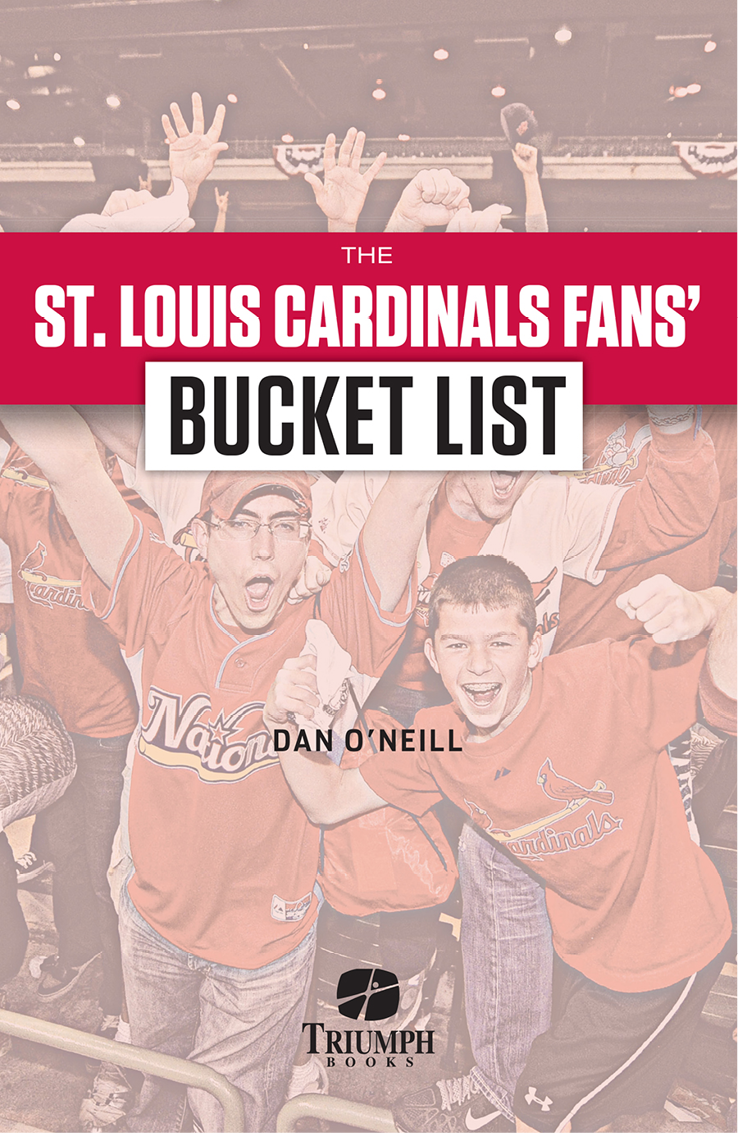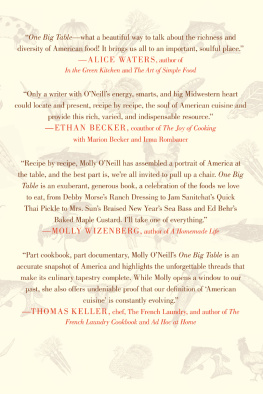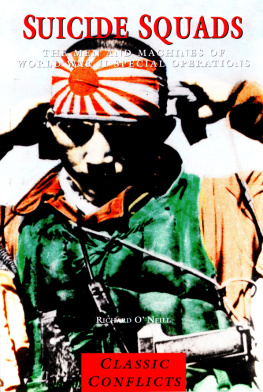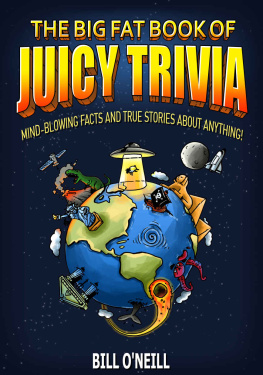
To my wife, Mary Pat, and my sons, Daniel, Riley, and Keegan, who fill my heart and complete my bucket list every day. And to my mom and dad, and all my brothers and sisters, who made growing up a fairy-tale adventure.
Contents
Foreword by Adam Wainwright
The sun shining through the cracks in my bedroom window tells me that morning is here. I can almost feel the cool spring air through the panes. My alarm clock is set to go off in another hour, but theres no need...Im wide awake.
There is a different vibe this morning that causes goose bumps to unexpectedly climb up and down my spine. I share a quick breakfast with my family, but my mind is somewhere else. Subconsciously, I am already locked on to the job at hand. Months and months of preparation have led me to this day.
My focus is sharper than normal. I hop in the truck and jump on the highway to head to work. Midway, I see the St. Louis Gateway Arch and it reminds me of where I am. As I pull off the exit, I can see thousands of people who have already begun placing their grills and banners and chairs out for the hours of tailgating ahead.
Its Opening Day in St. Louis, a recognized holiday here to everyone who is lucky enough to call it home. As I often do, just before I head through the gates, I look up at Busch Stadium with a sense of total awe.
This is where I get to work. Wow! As I head into the clubhouse, I see the pennants and the championship pictures and I smell the slight rankness in the air from past champagne celebrations.
All of this reminds me that I have a job to do and an organization to represent. Being a Cardinal is special, its fun, its importantand its just plain cool.
If theres any doubt about any of that, the Clydesdales and the close to 50,000 strong in the sea of red that make up our daily attendance will serve as a reminder.
Thats why I know Cardinals fansthose who live in St. Louis and those who follow from afarwill love checking the activities in this book off their bucket list. There are so many ways to show Cardinals pride in this city and elsewhere. Being a Cardinal is one of the best experiences a major league player might have. This book includes some of the best experiences one might have being a Cardinals fan.
Adam Wainwright, 2015
Introduction
Baseball had a unique presence in my boyhood home. It was always there, in stacks of periodicals, newspapers, and issues of Baseball Digest . It was kept in big scrapbooks, chronicled in neatly trimmed articles, illustrated with black-and-white photos, and personalized by letters from former players and legendary scribes such as Fred Lieb and Dick Young.
Baseball came to life through the glowing tubes of a solid-state radio, encased in wood and garnished with a tall glass of Pepsi, extra ice. It cordoned off one corner of the living room, furnished with a small table, a porcelain lamp, and a reclining leather chair. It was nurtured and preserved there with Elmers glue, paper clips, and a pair of scissors.
Sometimes it sounded like Radio Free Europe, strained by long distances, stressed by primitive technology, strangled by static interference. It arrived late at night, from places like New York, San Francisco, or Pittsburgh.
It was Morse code only my dad could decipher, unintelligible to most but music to his ears. He would listen intentlysitting in his chair, sipping his Pepsi, adjusting the dials, keeping score.
Baseball was about the Cardinals only in a begrudging sense, because it could no longer be about the Browns, the team he loved, the team that had left him in 1953. And ultimately, it wasnt about a single team as much as it was about passion.
Baseball was just a game in my house like The Honeymooners was just a show, like Kay Starr was just a singer, like a bull-dogging headlock was just a hold.
Baseball was a theology that sustained my father through a lifelong physical impairment, through several wars, through seven boys and two girls, through the rise and demise of the shoe business and his livelihood, and through my mothers chipped beef on toast.
My dad took me to games at the old ballpark at Grand and Dodier in St. Louis, but only if the Cardinals were playing one of his adopted teams, the Mets or Cubs. He also took me to semipro games at Heine Meine Field in south St. Louis. He knew who the players were...and he kept score.
Football? That was the time between the end of the season and the start of spring training. Golf, fishing, and tennis? The most boring activities in the world.
Baseball was bulletproof, noble and honest, something to preserve and protect. Baseball was the living gospel.
The game, and the Cardinals relationship to it, has never been about nation building, wearing red, chasing squirrels, clapping to Clydesdales. Busch Stadium III isnt necessarily baseball heaven, as they audaciously suggest before each Cardinals game. Its a ballpark, one of 30 in the major leagues.
At the National Baseball Hall of Fame induction ceremony in 1987, Ford C. Frick Award winner Jack Buck got up and waxed eloquently about his town. Buck said, I dont want to be belligerent about it. But I kind of think, Mr. [George] Steinbrenner and others, that St. Louis is not only the heartland of America, but the best baseball city in the United States.
Buck was a beautiful man, speaking from the heart, representing his constituency. Ever since, St. Louisans have adopted that sentiment in a literal sense, as a national identity, a birthmark. The truth is there are a number of great baseball cities and great baseball fans around the country. Its not a quantitative measurement, not a Guinness entry.
St. Louis hasnt cornered the market on baseball allegiance. Sure, its a nice idea, fun conversation, good marketing concept. After all, perception is reality. Say it often enough and people believe it. But if you have to tell someone what kind of baseball town you are, what kind of baseball town are you?
This isnt to suggest baseball isnt special in St. Louisit is. But there is so much beneath the surface, so much more than popular trends, product proliferation, and self-promotion.
What can be said is that baseball is rich and vibrant in St. Louis, and the Cardinals are the coagulant. Organized ball has been played here for more than 150 years. It was a baseball village long before it opened a Ballpark Village, when the town ran north and south instead of east and west.
St. Louis had pennants before it had televisions, before it had airports. By the time baseball arrived in Arlington, Texas, St. Louis had been to the World Series 12 times. In October 1944, St. Louis had two teams in a World Series that was played entirely at one ballpark. Travel-weary baseball writers get goose bumps when they read that.
Baseball hasnt always been the clean, decorous, symmetrical package it is now. It was gritty, quirky, even awkward at times. It was choked with bus exhaust and cluttered with pavement-pounding streetcars. It was segregated by color; filtered by right-field screens and limited views; embellished by Dixieland bands, Mighty Wurlitzer organs, and manual scoreboards.
It smelled like popcorn and cheap cigars. It felt like sticky concrete and wooden chairs. It sounded like exploding paper cups. It was a neighborhood joint, not an entertainment complex.
In the interest of full disclosure, I didnt play a lot of organized baseball growing up. I spent many more summer days immersed in the adjunct applications: Indian Ball, Fuzzball, Corkball, Hot Box, and Wiffle Ball. The game of choice was dictated by the number of kids in attendance.














